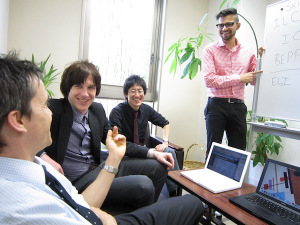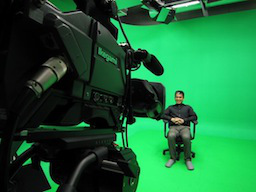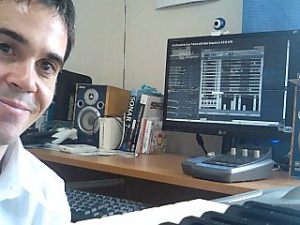ELI lecturer Jennifer Yphantides discusses teaching Peace Education in Japan. In this video, listen to how she has applied her 5 years of Peace Education experience in the Middle East to the Japanese university environment. Her students reflect on the class and share topics they are interested in. This is a great video not only to learn about Peace Education and its learning opportunities, but also useful for any teacher interested in invigorating class discussions.
Peace Education in Japan
22 12 2010Comments : Leave a Comment »
Categories : Teaching and Practice, Videos
Best Practice: Creating Video Projects with Japanese University Students
16 07 2010Rob Hirschel, ELI Lecturer, discusses a recent student video project in this episode of Best Practice. The project asks students to visually demonstrate a deep understanding of a vocabulary word while introducing them to basic video editing.
Hirschel describes the language aims of the project in detail. He directs his freshmen to explore a vocabulary word’s different meanings in context, collocations, and appropriate usage.
While teachers of foreign languages might find this video project as a useful exercise for developing deep knowledge of vocabulary, any teacher interested in trying video editing for the first time might find Rob’s reflections useful. This was his first time using basic Canon point and shoot digital cameras (not dedicated camcorders) along with Apple’s iMovie editing software. Along the way, he gives advice to teachers interested in creating their own video project: student benefits, project timeframes, and preparation tips.
Feel free to share any tips, questions, or thoughts on video projects with your students!
Vodpod videos no longer available.
Comments : 1 Comment »
Categories : Teaching and Practice, Videos
Understanding Japanese University Students
13 06 2010ELI Lecturer Dwayne Cover discusses various aspects of Japanese student and university life that teachers should consider in their day to day practice. Mr. Cover is a fourth year lecturer, co-coordinator of the International Communication Department’s Basic English Proficiency Project, and active member of the ELI’s Professional Development Committee. In April, he offered a workshop titled, “The Japanese University Context: A long way from home.” Cover says, “The most dangerous thing for people to do is to just come in and say…this is a university and this is how universities work.” Watch this video for practical advice to enhance your teaching approach in a Japanese University context. Feel free to comment and share your thoughts on this topic.
Vodpod videos no longer available.An abstract of Mr. Cover’s workshop follows:
The Japanese University Context: A long way from home
When new teachers arrive at KUIS, they are often entering the university teaching context for the first time. Naturally, they have assumptions and expectations for post-secondary institutions based upon their personal experiences; however, there are critical differences between Japanese universities and Western-based universities that present a significantly different teaching environment than what is often expected.
This workshop will offer an overview of the Japanese university context, e.g. Where do our students come from? What are their expectations when they arrive? What is daily university life like for Japanese students? What is expected of students when they graduate and join the workforce? The information presented in the workshop will be drawn from a number of sources: research projects conducted at KUIS, relevant literature, individual experiences, etc.
This workshop should be beneficial to instructors with differing levels of teaching experience in Japan: those who have taught in Japan will be invited to share their experiences with their colleagues; those who are new to this teaching context will have the opportunity to ask questions and gain a stronger understanding of the Japanese system, hopefully allowing them to acclimatize more easily.
Comments : 3 Comments »
Categories : Teaching and Practice, Videos
The 2010 ELI Intro Classroom video for students
5 05 2010Every April brings a fresh crop of teachers, learning advisors, and students to the ELI. While it’s impractical for all the students to meet each and every one of our lecturers, the ELI prioritizes creating a friendly atmosphere in our learning environment. In an effort to personalize our lecturers, the ELI has a tradition of creating a video introduction every year, which is then used in a classroom lesson.
Vodpod videos no longer available.
 ELI lecturers Joachim Castellano, Simon Cooke, Ashley Moore, Eric Setoguchi, and Paul Stone led this year’s ELI Introduction Video effort. The team met several times in April to plan both a video and an accompanying lesson plan.
ELI lecturers Joachim Castellano, Simon Cooke, Ashley Moore, Eric Setoguchi, and Paul Stone led this year’s ELI Introduction Video effort. The team met several times in April to plan both a video and an accompanying lesson plan.
The ELI emphasizes an interactive approach to media, and Moore, Setoguchi, and Stone created a lesson which both checks comprehension and generates discussion. In addition, the lesson is intended to be tailored to a teacher’s specific class environment. Setoguchi explains, “As teachers will typically use the video in different ways based on their teaching approach and class level, the handouts are as simple as possible and designed for teachers to combine and alter them as they wish.”
The video features various ELI’ers responding to random questions from a bag. Ashley Moore, who masterminded this year’s video concept, reasons, “We wanted to create a bit more variety,” than videos in years past, adding that the team, “wanted to move [the video] past standard self-introductions.”
The video was recorded and edited at Kanda University’s media production facilities.

Joachim Castellano edited the video, adding additional visual and aural effects to enhance comprehensibility. The video also features original music from Simon Cooke,
 who spiced up the introduction and preview versions with a track called “JunkFunk.”
who spiced up the introduction and preview versions with a track called “JunkFunk.”
Comments : Leave a Comment »
Categories : Teaching and Practice, Videos